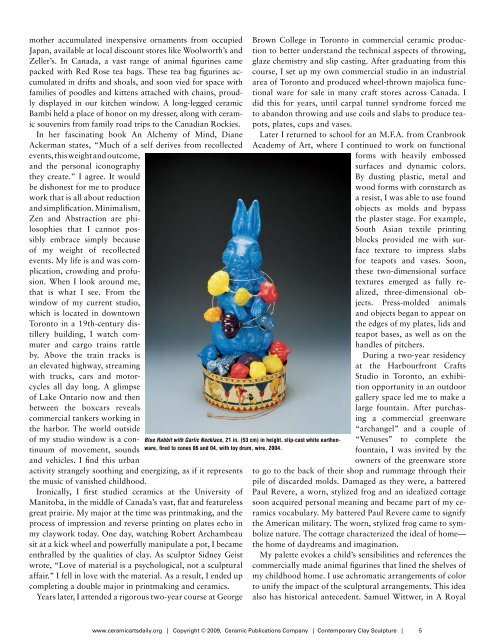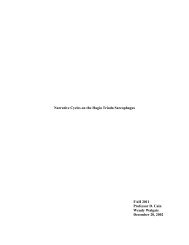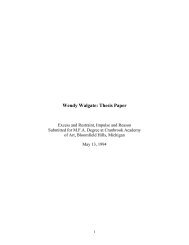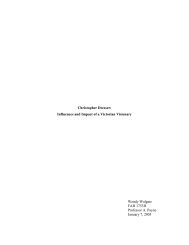contemporary clay sculpture - Wendy Walgate
contemporary clay sculpture - Wendy Walgate
contemporary clay sculpture - Wendy Walgate
You also want an ePaper? Increase the reach of your titles
YUMPU automatically turns print PDFs into web optimized ePapers that Google loves.
mother accumulated inexpensive ornaments from occupied<br />
Japan, available at local discount stores like Woolworth’s and<br />
Zeller’s. In Canada, a vast range of animal figurines came<br />
packed with Red Rose tea bags. These tea bag figurines accumulated<br />
in drifts and shoals, and soon vied for space with<br />
families of poodles and kittens attached with chains, proudly<br />
displayed in our kitchen window. A long-legged ceramic<br />
Bambi held a place of honor on my dresser, along with ceramic<br />
souvenirs from family road trips to the Canadian Rockies.<br />
In her fascinating book An Alchemy of Mind, Diane<br />
Ackerman states, “Much of a self derives from recollected<br />
events, this weight and outcome,<br />
and the personal iconography<br />
they create.” I agree. It would<br />
be dishonest for me to produce<br />
work that is all about reduction<br />
and simplification. Minimalism,<br />
Zen and Abstraction are philosophies<br />
that I cannot possibly<br />
embrace simply because<br />
of my weight of recollected<br />
events. My life is and was complication,<br />
crowding and profusion.<br />
When I look around me,<br />
that is what I see. From the<br />
window of my current studio,<br />
which is located in downtown<br />
Toronto in a 19th-century distillery<br />
building, I watch commuter<br />
and cargo trains rattle<br />
by. Above the train tracks is<br />
an elevated highway, streaming<br />
with trucks, cars and motorcycles<br />
all day long. A glimpse<br />
of Lake Ontario now and then<br />
between the boxcars reveals<br />
commercial tankers working in<br />
the harbor. The world outside<br />
of my studio window is a continuum<br />
of movement, sounds<br />
and vehicles. I find this urban<br />
activity strangely soothing and energizing, as if it represents<br />
the music of vanished childhood.<br />
Ironically, I first studied ceramics at the University of<br />
Manitoba, in the middle of Canada’s vast, flat and featureless<br />
great prairie. My major at the time was printmaking, and the<br />
process of impression and reverse printing on plates echo in<br />
my <strong>clay</strong>work today. One day, watching Robert Archambeau<br />
sit at a kick wheel and powerfully manipulate a pot, I became<br />
enthralled by the qualities of <strong>clay</strong>. As sculptor Sidney Geist<br />
wrote, “Love of material is a psychological, not a sculptural<br />
affair.” I fell in love with the material. As a result, I ended up<br />
completing a double major in printmaking and ceramics.<br />
Years later, I attended a rigorous two-year course at George<br />
Brown College in Toronto in commercial ceramic production<br />
to better understand the technical aspects of throwing,<br />
glaze chemistry and slip casting. After graduating from this<br />
course, I set up my own commercial studio in an industrial<br />
area of Toronto and produced wheel-thrown majolica functional<br />
ware for sale in many craft stores across Canada. I<br />
did this for years, until carpal tunnel syndrome forced me<br />
to abandon throwing and use coils and slabs to produce teapots,<br />
plates, cups and vases.<br />
Later I returned to school for an M.F.A. from Cranbrook<br />
Academy of Art, where I continued to work on functional<br />
forms with heavily embossed<br />
surfaces and dynamic colors.<br />
By dusting plastic, metal and<br />
wood forms with cornstarch as<br />
a resist, I was able to use found<br />
objects as molds and bypass<br />
the plaster stage. For example,<br />
South Asian textile printing<br />
blocks provided me with surface<br />
texture to impress slabs<br />
for teapots and vases. Soon,<br />
these two-dimensional surface<br />
textures emerged as fully realized,<br />
three-dimensional objects.<br />
Press-molded animals<br />
and objects began to appear on<br />
the edges of my plates, lids and<br />
teapot bases, as well as on the<br />
handles of pitchers.<br />
During a two-year residency<br />
at the Harbourfront Crafts<br />
Studio in Toronto, an exhibition<br />
opportunity in an outdoor<br />
gallery space led me to make a<br />
large fountain. After purchasing<br />
a commercial greenware<br />
“archangel” and a couple of<br />
Blue Rabbit with Garlic Necklace, 21 in. (53 cm) in height, slip-cast white earthen- “Venuses” to complete the<br />
ware, fired to cones 06 and 04, with toy drum, wire, 2004.<br />
fountain, I was invited by the<br />
owners of the greenware store<br />
to go to the back of their shop and rummage through their<br />
pile of discarded molds. Damaged as they were, a battered<br />
Paul Revere, a worn, stylized frog and an idealized cottage<br />
soon acquired personal meaning and became part of my ceramics<br />
vocabulary. My battered Paul Revere came to signify<br />
the American military. The worn, stylized frog came to symbolize<br />
nature. The cottage characterized the ideal of home—<br />
the home of daydreams and imagination.<br />
My palette evokes a child’s sensibilities and references the<br />
commercially made animal figurines that lined the shelves of<br />
my childhood home. I use achromatic arrangements of color<br />
to unify the impact of the sculptural arrangements. This idea<br />
also has historical antecedent. Samuel Wittwer, in A Royal<br />
www.ceramicartsdaily.org | Copyright © 2009, Ceramic Publications Company | Contemporary Clay Sculpture | 5





